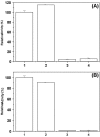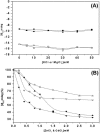Cation induced differential effect on structural and functional properties of Mycobacterium tuberculosis alpha-isopropylmalate synthase
- PMID: 17577419
- PMCID: PMC1919377
- DOI: 10.1186/1472-6807-7-39
Cation induced differential effect on structural and functional properties of Mycobacterium tuberculosis alpha-isopropylmalate synthase
Abstract
Background: Alpha-isopropylmalate synthase (MtalphaIPMS), an enzyme that catalyzes the first committed step of the leucine biosynthetic pathway of Mycobacterium tuberculosis is a potential drug target for the anti-tuberculosis drugs. Cations induce differential effect of activation and inhibition of MtalphaIPMS. To date no concrete mechanism for such an opposite effect of similarly charged cations on the functional activity of enzyme has been presented.
Results: Effect of cations on the structure and function of the MtalphaIPMS has been studied in detail. The studies for the first time demonstrate that different cations interact specifically at different sites in the enzyme and modulate the enzyme structure differentially. The inhibitors Zn2+ and Cd2+ ions interact directly with the catalytic domain of the enzyme and induce unfolding/denaturation of the domain. The activator K+ also interacts with the catalytic TIM barrel domain however, it does not induce any significant effect on the enzyme structure. Studies with isolated catalytic TIM barrel domain showed that it can carry out the catalytic function on its own but probably requires the non-catalytic C-terminal domain for optimum functioning. An important observation was that divalent cations induce significant interaction between the regulatory and the catalytic domain of MtalphaIPMS thus inducing structural cooperativity in the enzyme. This divalent cation induced structural cooperativity might result in modulation of activity of the catalytic domain by regulatory domain.
Conclusion: The studies for the first time demonstrate that different cations bind at different sites in the enzyme leading to their differential effects on the structure and functional activity of the enzyme.
Figures








Similar articles
-
Mycobacterium tuberculosis isocitrate lyase (MtbIcl): role of divalent cations in modulation of functional and structural properties.Proteins. 2008 Aug 15;72(3):892-900. doi: 10.1002/prot.21984. Proteins. 2008. PMID: 18275086
-
Kinetic analysis of the effects of monovalent cations and divalent metals on the activity of Mycobacterium tuberculosis alpha-isopropylmalate synthase.Arch Biochem Biophys. 2006 Jul 15;451(2):141-8. doi: 10.1016/j.abb.2006.03.030. Epub 2006 Apr 19. Arch Biochem Biophys. 2006. PMID: 16684501
-
Amino-acid substitutions at the domain interface affect substrate and allosteric inhibitor binding in α-isopropylmalate synthase from Mycobacterium tuberculosis.Biochem Biophys Res Commun. 2013 Apr 5;433(2):249-54. doi: 10.1016/j.bbrc.2013.02.092. Epub 2013 Mar 13. Biochem Biophys Res Commun. 2013. PMID: 23500460
-
Structural and functional characterization of α-isopropylmalate synthase and citramalate synthase, members of the LeuA dimer superfamily.Arch Biochem Biophys. 2012 Mar 15;519(2):202-9. doi: 10.1016/j.abb.2011.10.009. Epub 2011 Oct 19. Arch Biochem Biophys. 2012. PMID: 22033339 Review.
-
Protein-cation interactions: structural and thermodynamic aspects.Curr Protein Pept Sci. 2011 Jun;12(4):325-38. doi: 10.2174/138920311795906664. Curr Protein Pept Sci. 2011. PMID: 21401523 Review.
Cited by
-
From amino acid to glucosinolate biosynthesis: protein sequence changes in the evolution of methylthioalkylmalate synthase in Arabidopsis.Plant Cell. 2011 Jan;23(1):38-53. doi: 10.1105/tpc.110.079269. Epub 2011 Jan 4. Plant Cell. 2011. PMID: 21205930 Free PMC article.
-
Subdomain II of α-isopropylmalate synthase is essential for activity: inferring a mechanism of feedback inhibition.J Biol Chem. 2014 Oct 3;289(40):27966-78. doi: 10.1074/jbc.M114.559716. Epub 2014 Aug 15. J Biol Chem. 2014. PMID: 25128527 Free PMC article.
-
Role of Divalent Cations in Infections in Host-Pathogen Interaction.Int J Mol Sci. 2024 Sep 10;25(18):9775. doi: 10.3390/ijms25189775. Int J Mol Sci. 2024. PMID: 39337264 Free PMC article. Review.
-
Characterization of alpha-isopropylmalate synthases containing different copy numbers of tandem repeats in Mycobacterium tuberculosis.BMC Microbiol. 2009 Jun 9;9:122. doi: 10.1186/1471-2180-9-122. BMC Microbiol. 2009. PMID: 19505340 Free PMC article.
-
Entamoeba histolytica Phosphoserine aminotransferase (EhPSAT): insights into the structure-function relationship.BMC Res Notes. 2010 Mar 3;3:52. doi: 10.1186/1756-0500-3-52. BMC Res Notes. 2010. PMID: 20199659 Free PMC article.
References
-
- Kohlhaw G, Leary TR, Umbarger HE. Alpha-isopropylmalate synthase from Salmonella typhimurium. Purification and properties. J Biol Chem. 1969;244:2218–2225. - PubMed
MeSH terms
Substances
LinkOut - more resources
Full Text Sources
Molecular Biology Databases

